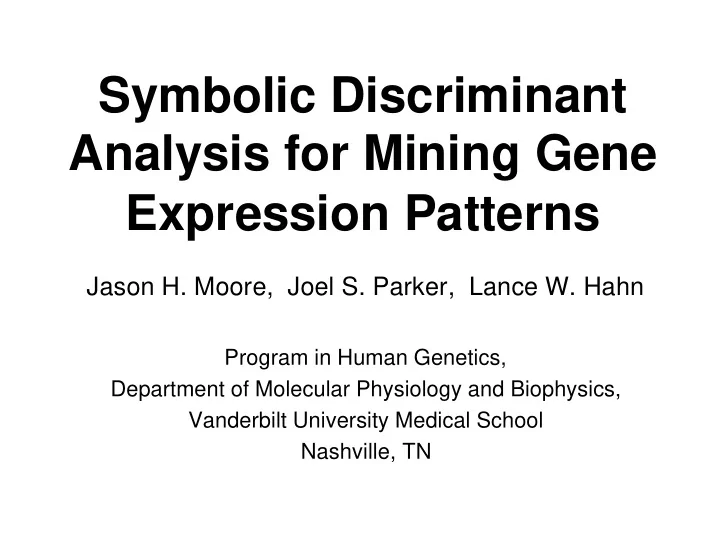

Symbolic Discriminant Analysis for Mining Gene Expression Patterns Jason H. Moore, Joel S. Parker, Lance W. Hahn Program in Human Genetics, Department of Molecular Physiology and Biophysics, Vanderbilt University Medical School Nashville, TN
Introduction • Questions – Can we classify and/or predict biological and clinical endpoints using gene expression data? Which genes are important? What is the pattern or statistical relationship among the genes? • Statistical Challenges – Modeling • What statistical method do you use? How do you select a statistical model? – Variable Selection • > 5,000 gene expression variables • How do you select a subset of variables? • 100 variables ~ 1.27 * 10 30 subsets • Objectives – Develop a computational or statistical methodology that is able to handle the model and variable selection challenges. – Use this methodology to identify patterns of gene expression that classify and predict clinical endpoints.
Symbolic Discriminant Analysis • Supply list of gene expression variables – X 1 , X 2 , … X 10,000 • Supply list of mathematical functions – +, -, *, /, abs, log, exp, sqrt • Use variables and functions as building blocks s x = x x 3 / * ij 1 ij 2 ij ij
y c Symbolic Discriminant Analysis n e • Supervised classification approach • Use parallel genetic programming (GP) to build symbolic u discriminant functions • Misclassification rate is fitness function q * e A B / X 1 r F X 3 X 2 Symbolic Discriminant Scores S = X 1 * X 2 / X 3
Application to Leukemia Data • Leukemia Data (Golub et al. 1999) – Dataset 1 (n=38, training) – Dataset 2 (n=34, testing) – ~7100 expressed genes measured using Affymetrix oligonucleotide chips • Cross Validation Strategy – Divide the training dataset into 38 equal parts. – Optimize SDA with each 37/38 of data. – Select SDA models that minimize the classification error and correctly predict the 1/38 of the data left out. – Estimate the prediction error using the testing dataset (n=34). • Genetic Programming Settings – Population Size: 500 – Iterations: 100 – Populations: 4 – Migration of best solutions every 25 iterations – Crossover probability: 0.6 – Maximum depth: 6
Results • Identified 2 ‘near-perfect’ models – Classified 38/38 correctly – Predicted 33/34 correctly • Identified 16 ‘very good’ models – Classified 38/38 correctly – Predicted 32/34 correctly • Identified 36 ‘good’ models – Classified 38/38 correctly – Predicted 31/34 correctly
* ‘Near-Perfect’ Model 1 + X 2555 - X 1153 X 2289 X 3193 Y= X * (X + X - X ) 2555 1153 2289 3193
Symbolic Discriminant Score ‘Near-Perfect’ Model 1 500000 1000000 1500000 0 ALL AML ALL AML Training Testing
‘Near-Perfect’ Model 2 + X 1835 X 2546 Y= X + X 1835 2546
‘Near-Perfect’ Model 2 2000 Symbolic Discriminant Score 1500 1000 500 0 ALL AML ALL AML Training Testing
Which Genes Were Identified? • Model 1: Y= X * (X + X - X ) 2555 1153 2289 3193 – X 2555 : Testis-specific cDNA on 17q • Cloned from a translocation, t(12;17), in a campomelic dysplasia patient. – X 1153 : Erythroid beta-spectrin • Major component of red cell membrane, expressed during normal erythropoiesis – X 2289 : Adipsin • Part of a gene cluster expressed during myeloid cell differentiation. – X 3193 : Nucleoporin 98 • Fuses with HOXA9 during an AML associated translocation, t(7;11)(p15;p15). • Model 2: Y= X + X 2546 1835 – X 1835 : CD33 • Differentiation antigen of AML progenitor cells. – X 2546 : Rho E • Part of Rho family of signal transduction proteins • Lacks GTPase activity
Conclusions • Symbolic discriminant analysis is a powerful alternative to traditional multivariate statistical methods. • We anticipate this will be an important methodology to add to the repertoire approaches for mining gene expression patterns.
Recommend
More recommend